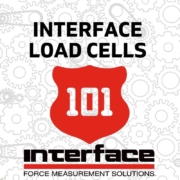Proper Installation of LowProfile Load Cells Ensures Accurate Tension Measurements
 Interface LowProfile Load Cell models 1000, 1100, 1200, and 3200 series are engineered for high-accuracy tension measurement applications.
Interface LowProfile Load Cell models 1000, 1100, 1200, and 3200 series are engineered for high-accuracy tension measurement applications.
Proper installation is paramount to achieving the most accurate and reliable results. Here are some tips related to the typical tension installation of these load cell series, along with key takeaways and common tension measurement applications using Interface’s popular LowProfile Load Cells.
The Foundation: A Rigid and Flat Mounting Surface
The accuracy of your load cell begins with its foundation. Our LowProfile load cells must be mounted on a flat and rigid surface that resists any appreciable deformation under load. If the mounting surface bends or twists, it will introduce unwanted forces and inaccuracies into your measurements.
We highly recommend using an Interface base or mounting plate specifically designed for your load cell model to guarantee this crucial stability. If using an Interface base isn’t feasible for your setup, ensure the alternative surface offers equivalent rigidity and flatness.
Tip #1 – Direction Matters: Axial Force Sensitivity
These load cells are engineered to measure forces acting directly perpendicular to their mounting surface, primarily the axial force. It’s important to understand that Interface load cells respond to forces in the axis perpendicular to the mounting surface. A load cell’s response to a non-axial force is proportional to that force times the cosine of its angle with the loading axis.
This means that any force applied at an angle to the intended direction of tension will have a reduced impact on the reading. To achieve the most accurate measurements, strive to align the applied tension force precisely along the load cell’s central axis. Minimizing off-axis loading is crucial for obtaining reliable data.
Tip #2 – Securely Anchored: Mounting the Load Cell
Once you have a suitable mounting surface, the next step is to attach the load cell securely. Position the load cell on the flat surface. Then, secure it by using a spanner wrench to tighten the load cell via one of the four strategically placed holes on the side of its base. This ensures the load cell is firmly fixed to your mounting structure. Note, using the spanner wrench only works when a base is installed on a load cell.
Tip #3 – Connecting the Force: Rod End Bearing and Jam Nut Installation
Let’s focus on how the tension force will be transmitted to the load cell. This typically involves installing a rod end bearing and a jam nut:
- Install the rod end bearing. Carefully screw the rod end bearing into the threaded top of the load cell. Ensure it’s threaded to the proper depth for secure connection and force transmission.
- Secure the rod end bearing with the jam nut. Once the rod end bearing is at the desired depth, it must be locked into place. This is accomplished by tightening the jam nut against the top of the load cell with a torque wrench. Using the proper torque specification for your specific load cell model is crucial. Consult the manufacturer’s documentation for these values.
Important Note for Higher Capacities: Securing the jam nut differs for load cells with capacities of 12,500 lbf or greater. Avoid using a torque wrench on these higher capacity models. Instead, pull the thread adapter to 110% to 140% of the load cell’s capacity to pre-load the connection. Then, hand-tighten the jam nut. This method securely fastens the jam nut and the thread adapter to the load cell, preventing damage.
Tip #4: Final Connection: Attaching the Clevis
With the rod end bearing securely in place, the final mechanical connection involves attaching the clevis. Align the holes. Carefully align the clevis pin’s holes on both the clevis and the rod end bearing. Once the holes are perfectly aligned, insert the clevis pin through them. Finally, secure the clevis pin using the supplied cotter pin. This prevents the pin from accidentally dislodging during operation.
With all the mechanical components correctly installed and secured, your system can safely apply tension force to the load cell.
Common Applications for Interface LowProfile Tension Load Cells
These versatile load cells are used in various industries and testing scenarios where precise measurement of tension force is critical. Here are a few tension testing application examples:
- Material Testing: Determining the tensile strength of materials like metals, plastics, and textiles by pulling them apart until failure.
- Cable and Wire Testing: This involves evaluating the breaking strength and performance characteristics of cables, wires, and ropes under tension.
- Suspension System Testing: Measuring the forces and loads in suspension components for automotive, aerospace, and other applications.
- Weighing and Batching Systems: Implementing tension load cells in hanging scales or systems where materials are suspended and weighed.
- Structural Monitoring: To ensure safety and integrity, assess the tension in structural elements, such as bridges, buildings, and pipelines.
- Force Calibration: Using highly accurate tension load cells as reference standards for calibrating other force measurement devices.
- Robotics and Automation: Measuring and controlling tension forces in robotic arms, actuators, and automated assembly lines.
- Aerospace Testing: Evaluating the tensile loads on aircraft components, control surfaces, and landing gear.
Key Takeaways for Successful Tension Installation
- Flat and Rigid Mounting: This is the non-negotiable foundation for accurate readings.
- Axial Force Alignment: Ensure the tension force acts directly along the axis of the load cell.
- Secure Mounting: Properly tighten the load cell to the mounting structure.
- Capacity-Specific Torque: Follow the correct tightening procedures for the jam nut, especially the no-torque rule for higher capacities.
- Sequential Installation: Follow the steps outlined for the rod end bearing and clevis attachment.
Adhering to the specified mounting procedures, including ensuring a flat and rigid mounting surface and using the proper tightening methods (especially the distinction between using a torque wrench for lower capacities versus a pre-load and hand-tightening for higher capacities), is essential for the accuracy, reliability, and longevity of your Interface Models 1000, 1100, 1200, and 3200 series LowProfile load cells in tension applications. Incorrect installation can lead to inaccurate readings, sensor damage, and potentially unsafe operation.
Always consult the complete load cell model specifications and installation instructions for detailed specifications, precise torque values (where applicable), critical safety precautions, and any specific requirements unique to your application and the model.
By understanding the proper installation techniques, you can unlock the full potential of your Interface LowProfile load cells and achieve accurate and reliable tension force measurements in your specific application.








